Countback elections
On this page
Prior to the ordinary local government elections held in December 2021, amendments to legislation enabled councils in New South Wales to choose for the first time to use countback elections, instead of by-elections, to fill any councillor vacancies arising after the ordinary elections.
Of the 128 local councils in New South Wales, 99 passed a resolution to use countback elections. Four councils did not conduct ordinary elections in 2021 and therefore countback is not yet an option for them (these four councils are Balranald Shire Council, Central Coast Council, Central Darling Shire Council and Wingecarribee Shire Council). The remaining 25 councils will continue to require a by-election to be conducted should a casual vacancy occur.
Should a countback election be conducted, the count is conducted using the same ballot papers from, and the same proportional representation voting count system as, the previous general election (that is, the ballot papers from the local government elections held on 4 December 2021.
Timeline
The timeline for a countback election is:
-
The Electoral Commissioner is notified of a casual vacancy, within seven days of it occuring.
-
A Returning Officer is appointed within 14 days of the notification of the vacancy.
-
Casual vacancy notices are issued within 14 days of the appointment of the returning officer.
-
Where a candidate is interested, they must submit a formal application to the returning officer. The application period closes after 10 days of the notices being issued.
-
The countback is conducted at least 14 days from when the vacancy notices are issued and no more than 49 days from when the casual vacancy occurred.
If there are no eligible candidates, an attendance by-election must be held. If there is only one eligible candidate, that candidate is elected. If there are multiple eligible candidates, a countback election is conducted.
How votes are counted
The countback election will be run using the same ballot papers from, and the same proportional representation voting count system as, the general election.
The countback election is run with all ineligible candidates (e.g. councillors who have vacated their seat) being disregarded and their preferences reallocated accordingly. In other words, each ballot paper with that candidate as a preference would be allocated to the candidate with the next highest preference on that ballot paper.
Example 1: Councillor Sue Jones resigns
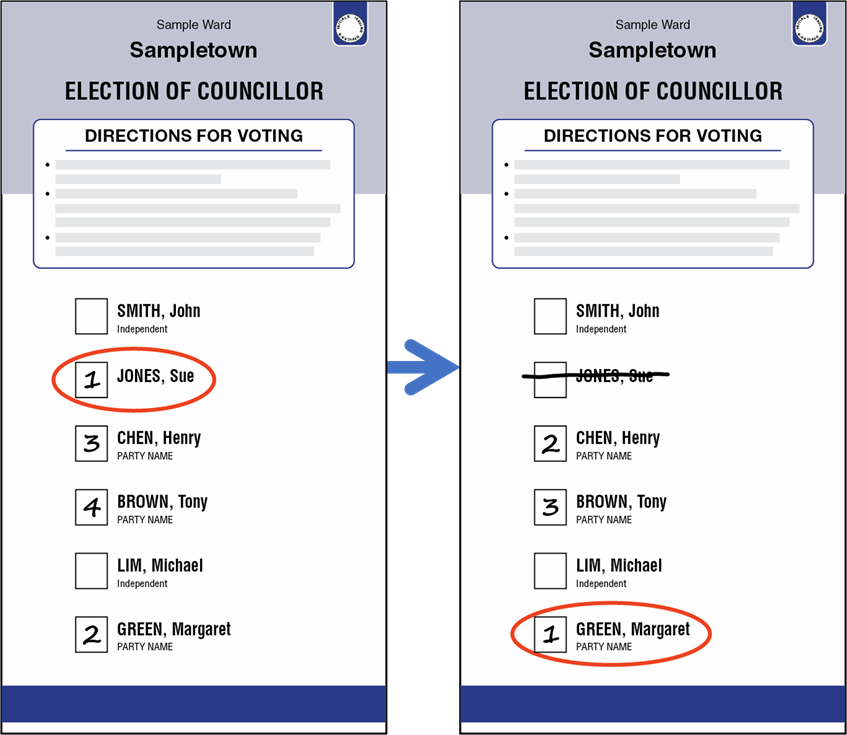
Left: Original ballot paper. Right: Countback preferences.
Example 2: Councillor Sue Jones resigns
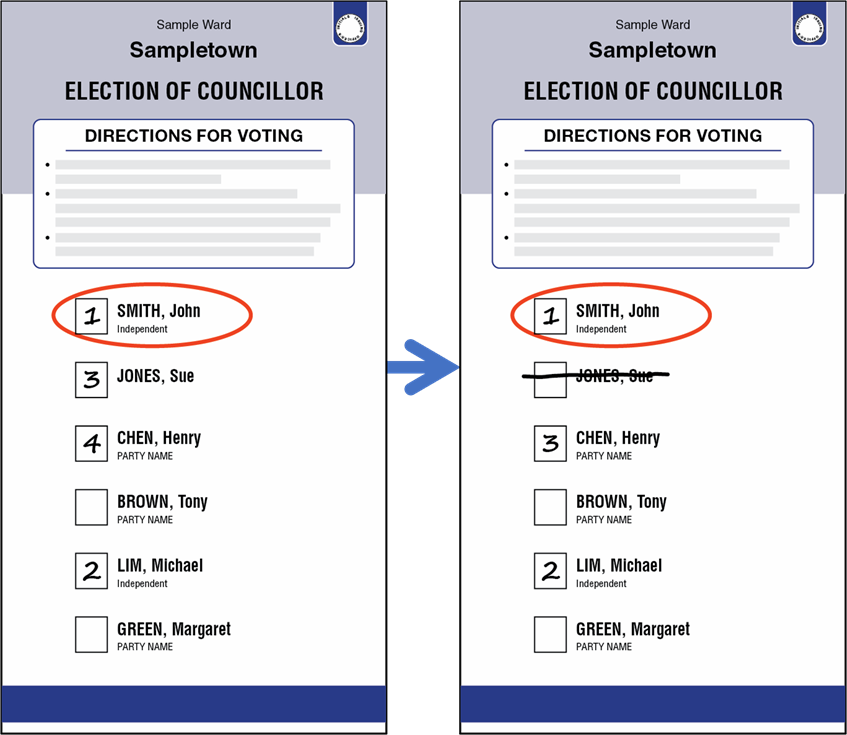
Left: Original ballot paper. Right: Countback preferences.
In the case of groups, if the first candidate in a group is vacating their seat, the Above The Line preferences for that group would be allocated to the second candidate in that group, as would any Below The Line preferences that marked the first candidate in that group as 1 and the second candidate in that group as 2.
Example 3: Councillor John Brown resigns
Original ballot paper – Above The Line vote for Group A
-
1st preference for Brown
-
2nd preference for Leigh
-
3rd preference for Ngyuen
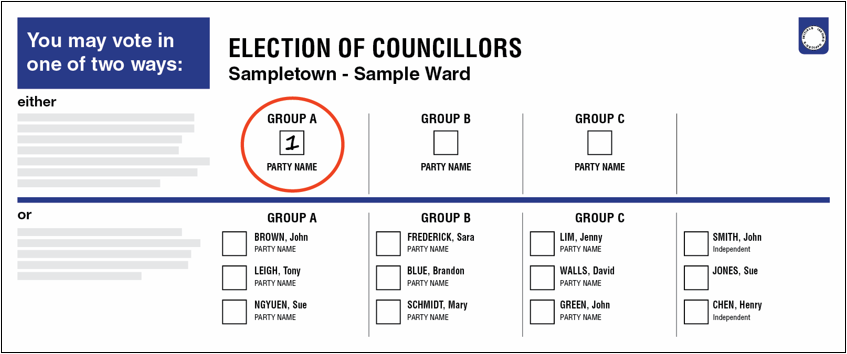
Countback preference – Above The Line vote for Group A
-
1st preference for Leigh
-
2nd preference for Ngyuen
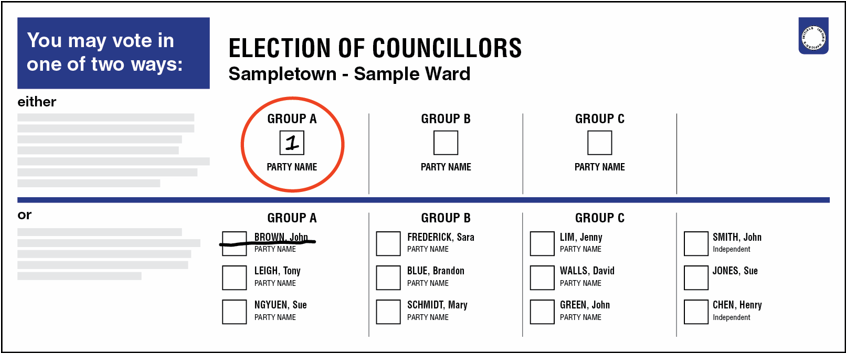
Example 4: Councillor John Brown resigns
Original ballot paper – Below The Line vote
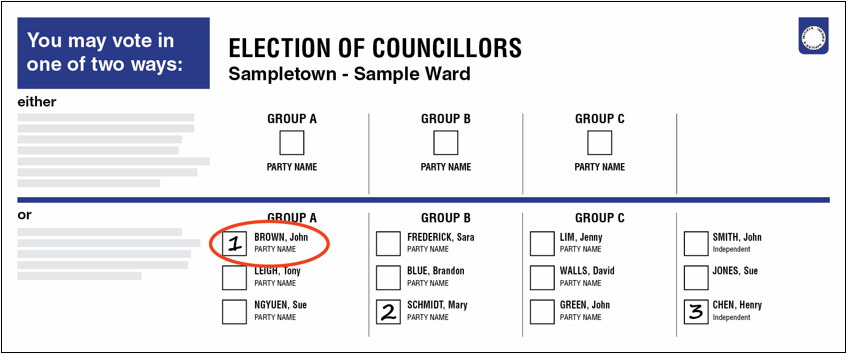
Countback preferences – Below The Line vote
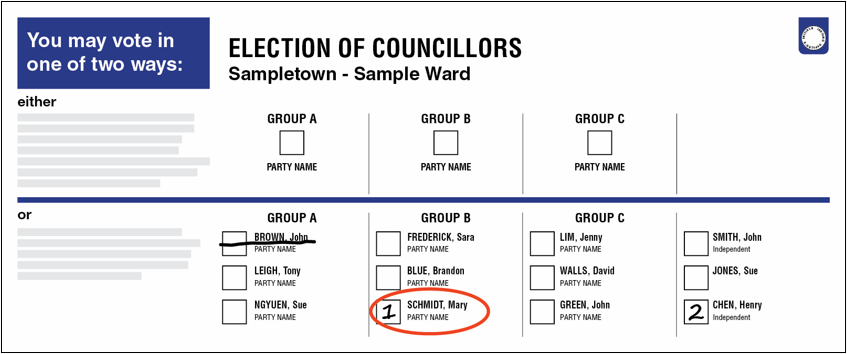
When the countback election is conducted, the same number of candidates will be “elected” as there were vacancies at the general election (because the same voting count system is used). Of these, the first newly “elected” candidate (i.e. not a sitting councillor) will be the candidate to be elected.
If a non-participating candidate (i.e. a candidate who did not want to considered for election in this countback election) was elected, their status is changed to ineligible and the countback is run again. This newly ineligible candidate will be disregarded and their preferences reallocated accordingly. This process will continue until an eligible candidate is elected.
Eligible candidates and the council are then notified of the result.
At a countback election, a sitting councillor cannot be unelected, and non-eligible candidates cannot be elected.
Councils using countback elections
|
Council |
Council |
Council |
|---|---|---|
|
Albury |
Glen Innes Severn |
Oberon |
|
Armidale |
Goulburn Mulwaree |
Orange |
|
Ballina |
Greater Hume |
Parkes |
|
Bathurst |
Griffith |
Parramatta |
|
Bayside |
Gunnedah |
Port Macquarie-Hastings |
|
Bega Valley |
Gwydir |
Port Stephens |
|
Bellingen |
Hawkesbury |
Queanbeyan-Palerang |
|
Berrigan |
Hay |
Randwick |
|
Blacktown |
Hilltops |
Shellharbour |
|
Bland |
Hornsby |
Shoalhaven |
|
Blayney |
Inner West |
Singleton |
|
Bogan |
Inverell |
Snowy Monaro |
|
Byron |
Junee |
Snowy Valleys |
|
Cabonne |
Kempsey |
Sutherland |
|
Camden |
Kiama |
Sydney |
|
Campbelltown |
Lake Macquarie |
Tamworth |
|
Canada Bay |
Lane Cove |
Temora |
|
Canterbury-Bankstown |
Lithgow |
The Hills |
|
Cessnock |
Liverpool |
Tweed |
|
Clarence Valley |
Liverpool Plains |
Upper Hunter |
|
Coffs Harbour |
Lockhart |
Upper Lachlan |
|
Coolamon |
Maitland |
Walcha |
|
Coonamble |
Mid-Coast |
Walgett |
|
Cootamundra-Gundagai |
Mid-Western |
Warren |
|
Cowra |
Moree Plains |
Warrumbungle |
|
Cumberland |
Mosman |
Waverley |
|
Dungog |
Muswellbrook |
Weddin |
|
Edward River |
Nambucca Valley |
Wentworth |
|
Eurobodalla |
Narrabri |
Willoughby |
|
Federation |
Narrandera |
Wollondilly |
|
Forbes |
Newcastle |
Wollongong |
|
Georges River |
North Sydney |
Woollahra |
|
Gilgandra |
Northern Beaches |
Yass Valley |
Councils not running countback elections
|
Council |
Council |
|---|---|
|
Balranald |
Lachlan |
|
Blue Mountains |
Leeton |
|
Bourke |
Lismore |
|
Brewarrina |
Murray River |
|
Broken Hill |
Murrumbidgee |
|
Burwood |
Narromine |
|
Carrathool |
Penrith |
|
Central Coast |
Richmond Valley |
|
Central Darling |
Ryde |
|
Cobar |
Strathfield |
|
Dubbo |
Tenterfield |
|
Fairfield |
Uralla |
|
Hunters Hill |
Wagga Wagga |
|
Ku-ring-gai |
Wingecarribee |
|
Kyogle |
|
Countback elections are described in Schedule 9A of the Local Government (General) Regulation 2021.
A countback election is used to elect a councillor to fill a single vacancy, where the vacating councillor was elected under the proportional representation method (i.e. where two or more candidates were elected at a local government ordinary election). If there are multiple vacancies, a separate countback election is held for each vacancy.
The returning officer contacts all unelected candidates from the local government ordinary election who may still qualify to be elected to the office of councillor. Where the candidate is interested, they must submit a formal application to the returning officer. All candidates who submit and do not withdraw their application, become eligible candidates.
